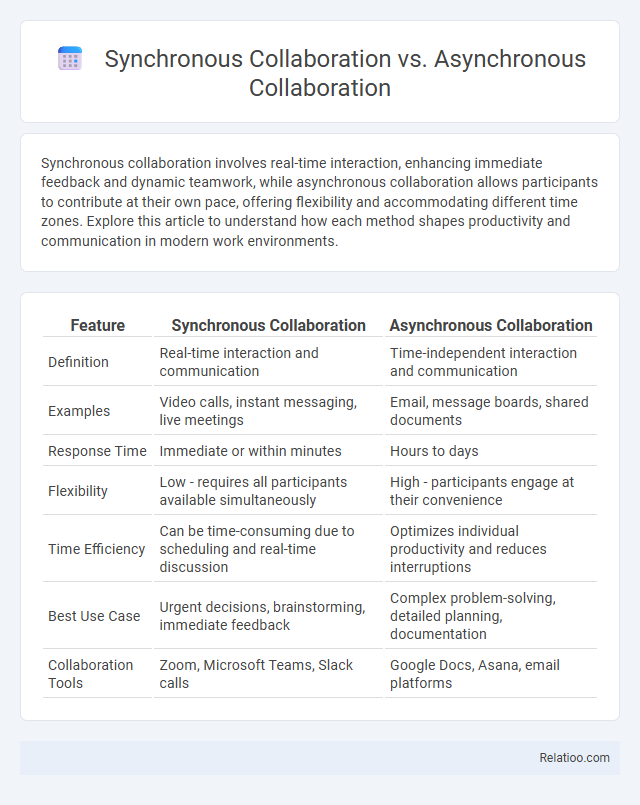Synchronous collaboration involves real-time interaction, enhancing immediate feedback and dynamic teamwork, while asynchronous collaboration allows participants to contribute at their own pace, offering flexibility and accommodating different time zones. Explore this article to understand how each method shapes productivity and communication in modern work environments.
Table of Comparison
| Feature | Synchronous Collaboration | Asynchronous Collaboration |
|---|---|---|
| Definition | Real-time interaction and communication | Time-independent interaction and communication |
| Examples | Video calls, instant messaging, live meetings | Email, message boards, shared documents |
| Response Time | Immediate or within minutes | Hours to days |
| Flexibility | Low - requires all participants available simultaneously | High - participants engage at their convenience |
| Time Efficiency | Can be time-consuming due to scheduling and real-time discussion | Optimizes individual productivity and reduces interruptions |
| Best Use Case | Urgent decisions, brainstorming, immediate feedback | Complex problem-solving, detailed planning, documentation |
| Collaboration Tools | Zoom, Microsoft Teams, Slack calls | Google Docs, Asana, email platforms |
Introduction to Collaborative Work
Synchronous collaboration involves real-time interaction where team members communicate and work together simultaneously, enhancing immediate feedback and dynamic problem-solving. Asynchronous collaboration allows participants to contribute at different times, offering flexibility and accommodating diverse schedules while maintaining continuous progress. Synchronization ensures that all collaborative efforts are aligned and updated across platforms, preventing conflicts and maintaining consistency in shared tasks and documents.
Defining Synchronous Collaboration
Synchronous collaboration involves real-time interaction where team members communicate and work together simultaneously, enhancing immediate feedback and rapid decision-making. This contrasts with asynchronous collaboration, where participants engage at different times, allowing flexibility but potentially slowing progress. Understanding the difference helps you choose the optimal approach to maximize productivity and communication efficiency in your projects.
Understanding Asynchronous Collaboration
Asynchronous collaboration enables team members to work independently without requiring simultaneous participation, allowing flexibility across different time zones and schedules. Tools like email, project management software, and shared documents facilitate communication and progress tracking without waiting for real-time responses. Understanding asynchronous collaboration improves productivity by reducing bottlenecks and empowers diverse, distributed teams to contribute efficiently.
Key Differences Between Synchronous and Asynchronous Collaboration
Synchronous collaboration involves real-time interaction where team members communicate simultaneously, such as in video calls or live chats, promoting instant feedback and faster decision-making. Asynchronous collaboration allows participants to engage at different times, using tools like emails or shared documents, offering flexibility and accommodating diverse schedules. Synchronization refers to the process of aligning data or work outputs across platforms or team members, ensuring consistency regardless of whether collaboration is synchronous or asynchronous.
Advantages of Synchronous Collaboration
Synchronous collaboration enables real-time communication and instant feedback, enhancing teamwork efficiency and reducing misunderstandings. Your team benefits from immediate problem-solving and dynamic interaction, which fosters stronger relationships and quicker decision-making. This method supports active engagement, making it ideal for brainstorming sessions and urgent project updates.
Benefits of Asynchronous Collaboration
Asynchronous collaboration enhances productivity by allowing team members to contribute on their own schedules, reducing dependency on real-time interactions and minimizing delays. It supports global teams across different time zones, promoting inclusivity and continuous progress without the constraints of simultaneous participation. This flexibility leads to more thoughtful communication and higher-quality contributions by giving individuals time for reflection and research before responding.
Challenges of Real-Time Collaboration
Real-time collaboration faces significant challenges such as latency issues, data conflicts, and synchronization errors that can disrupt seamless user interaction. Synchronous collaboration demands continuous connectivity and instant data exchange, often leading to bandwidth constraints and user interface lag. In contrast, asynchronous collaboration mitigates some timing conflicts but introduces difficulties in maintaining data consistency and version control, complicating effective synchronization across platforms.
Limitations of Asynchronous Communication
Asynchronous collaboration often faces limitations such as delayed feedback, which can slow decision-making and reduce overall productivity in time-sensitive projects. Lack of real-time interaction may lead to misunderstandings and decreased team cohesion, especially when complex topics require immediate clarification. Compared to synchronous collaboration that enables instant communication, asynchronous methods struggle with maintaining engagement and ensuring accountability among distributed teams.
Choosing the Right Collaboration Approach
Choosing the right collaboration approach depends on project timelines, team dynamics, and communication needs. Synchronous collaboration, involving real-time interaction through video calls or chats, enhances immediate feedback and dynamic problem-solving but requires simultaneous availability. Asynchronous collaboration allows team members to contribute at their own pace using tools like emails or shared documents, fostering flexibility and thoughtful input, while synchronization ensures data consistency across platforms, supporting smooth integration regardless of interaction timing.
Best Practices for Blending Synchronous and Asynchronous Methods
Blending synchronous and asynchronous collaboration effectively requires clear communication protocols and well-defined roles to maximize productivity and flexibility. Your team should leverage synchronous methods like video calls for real-time discussions and decision-making, while using asynchronous tools such as shared documents and messaging platforms for thoughtful input and task tracking. Establishing consistent check-in schedules and setting expectations around response times ensures smooth synchronization, fostering a collaborative environment that adapts to diverse workstyles and time zones.

Infographic: Synchronous Collaboration vs Asynchronous Collaboration
 relatioo.com
relatioo.com